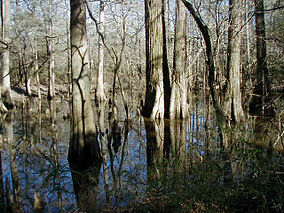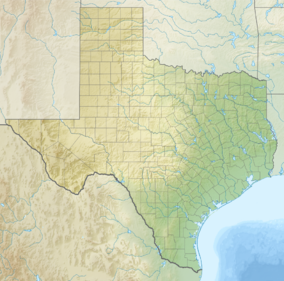 Global Information
Global InformationBig Thicket information
| Big Thicket National Preserve | |
|---|---|
 | |
  | |
| Location | Southeast Texas, U.S. |
| Nearest city | Kountze, Texas |
| Coordinates | 30°32′51″N 94°20′24″W / 30.54750°N 94.34000°W |
| Area | 113,122 acres (457.79 km2)[1] |
| Authorized | October 11, 1974 |
| Visitors | 137,722 (in 2011)[2] |
| Governing body | National Park Service |
| Website | Big Thicket National Preserve |
The Big Thicket[3] is the name given to a somewhat imprecise region of a heavily forested area of Southeast Texas in the United States. This area represents a portion of the mixed pine-hardwood forests or "Piney Woods" of the Southeast US.[4] The National Park Service established the Big Thicket National Preserve (BTNP) within the region in 1974 and it is recognized as a biosphere reserve by UNESCO. Although the diversity of animals in the area is high for a temperate zone with over 500 vertebrates, it is the complex mosaic of ecosystems and plant diversity that is particularly remarkable. Biologists have identified at least eight, and up to eleven, ecosystems in the Big Thicket area. More than 160 species of trees and shrubs, 800 herbs and vines, and 340 types of grasses are known to occur in the Big Thicket, and estimates as high as over 1000 flowering plant species and 200 trees and shrubs have been made, plus ferns, carnivorous plants, and more. The Big Thicket has historically been the most dense forest region in Texas.[5][6][7][8]
Native Americans are known to have lived and hunted in the area nomadically, but did not establish permanent settlements there before the Alabama–Coushatta settled in the northeast about 1780. Spanish explorers and missionaries generally avoided the area and routed their roads around it. Logging in the late 19th and 20th centuries dramatically reduced the forest concentration. Efforts to save the Big Thicket from the devastation of oil and lumber industries started as early as the 1920s with the founding of the East Texas Big Thicket Association by Richard Elmer Jackson.[6][9]
Conservatively the area occupies all of Hardin County, most of Polk, and Tyler Counties, and parts of Jasper, Liberty and San Jacinto Counties, including areas between the Neches River on the east, the Trinity River on the west, Pine Island Bayou on the south, to the higher elevations and older Eocene geological formations to the north. Broader interpretations have included the area between the Sabine River on the east and the San Jacinto River on the west including much of Montgomery, Newton, Trinity, and Walker Counties, as well.[6][10][11] Several attempts to define the boundaries of the Big Thicket have been made, including a biological survey in 1936 which included over 3,350,000 acres (13,600 km2) covering 14 counties.[12] A later botanical based study in 1972 included a region of over 2,000,000 acres (8,100 km2).[13] This same habitat extends into Louisiana and eastward.[14]
- ^ "Listing of acreage – December 31, 2014" (XLSX). Land Resource Division, National Park Service. Retrieved October 24, 2015. (National Park Service Acreage Reports)
- ^ "NPS Annual Recreation Visits Report". National Park Service. Retrieved May 14, 2012.
- ^ "Sam Houston State University Archives Collection - The Big Thicket". Texas Archive of the Moving Image. Retrieved December 2, 2019.
- ^ MacRoberts, M.H. (2010). "Vertebrate Richness and Biogeography in the Big Thicket of Texas". The American Midland Naturalist. 164 (1): 37–42. doi:10.1674/0003-0031-164.1.37. S2CID 85602718.
- ^ Peacock, Howard (1994). Nature Lover's Guide to the Big Thicket. College Station, Texas: Texas A&M University Press. ISBN 978-0-8909-6596-2.
- ^ a b c Ajilvsgi, Geyata (1979). Wild Flowers of the Big Thicket: East Texas, and Western Louisiana. College Station, Texas: Texas A&M University Press. ISBN 978-0-8909-6064-6. Archived from the original on December 12, 2023. Retrieved November 11, 2021.
- ^ "Big Thicket National Preserve". National Park Service. October 25, 2021. Archived from the original on October 26, 2019. Retrieved October 23, 2019.
- ^ "Big Thicket, Plants". National Park Service. July 13, 2020. Archived from the original on December 22, 2019. Retrieved December 22, 2019.
- ^ Abernethy, Francis Edward (September 30, 2020) [1976]. "Big Thicket". Handbook of Texas. Texas State Historical Association. Archived from the original on November 11, 2021. Retrieved November 11, 2021.
- ^ James J., Cozine Jr. (2004). Saving the Big Thicket From Exploration to Preservation, 1685–2003. University of North Texas Press. p. 4. ISBN 1-57441-175-6. Archived from the original on December 12, 2023. Retrieved May 30, 2016.
- ^ Watson, Geraldine Ellis (2006). Big Thicket Plant Ecology: An Introduction. #5 in Temple Big Thicket Series (Third ed.). University of North Texas Press. ISBN 978-1-5744-1214-7. Archived from the original on December 12, 2023. Retrieved November 12, 2021.
- ^ Parks, H. B.; Cory, V. L.; et al. (1936). Biological survey of the East Texas Big Thicket area: The fauna and flora of the Big Thicket area. Special Publication sponsored by the Texas Academy of Sciences. Privately Published.
- ^ McLeod, C. A. (1972). The Big Thicket Forest of Eastern Texas: A Brief Historical Botanical and Ecological Report. Huntsville, Texas: Sam Houston State University.
- ^ MacRoberts, Michael H.; MacRoberts, Barbara R. (March 2004). "The Big Thicket: Typical or Atypical?". East Texas Historical Journal. 42 (1): 42–51. Archived from the original on July 9, 2020. Retrieved December 22, 2019.